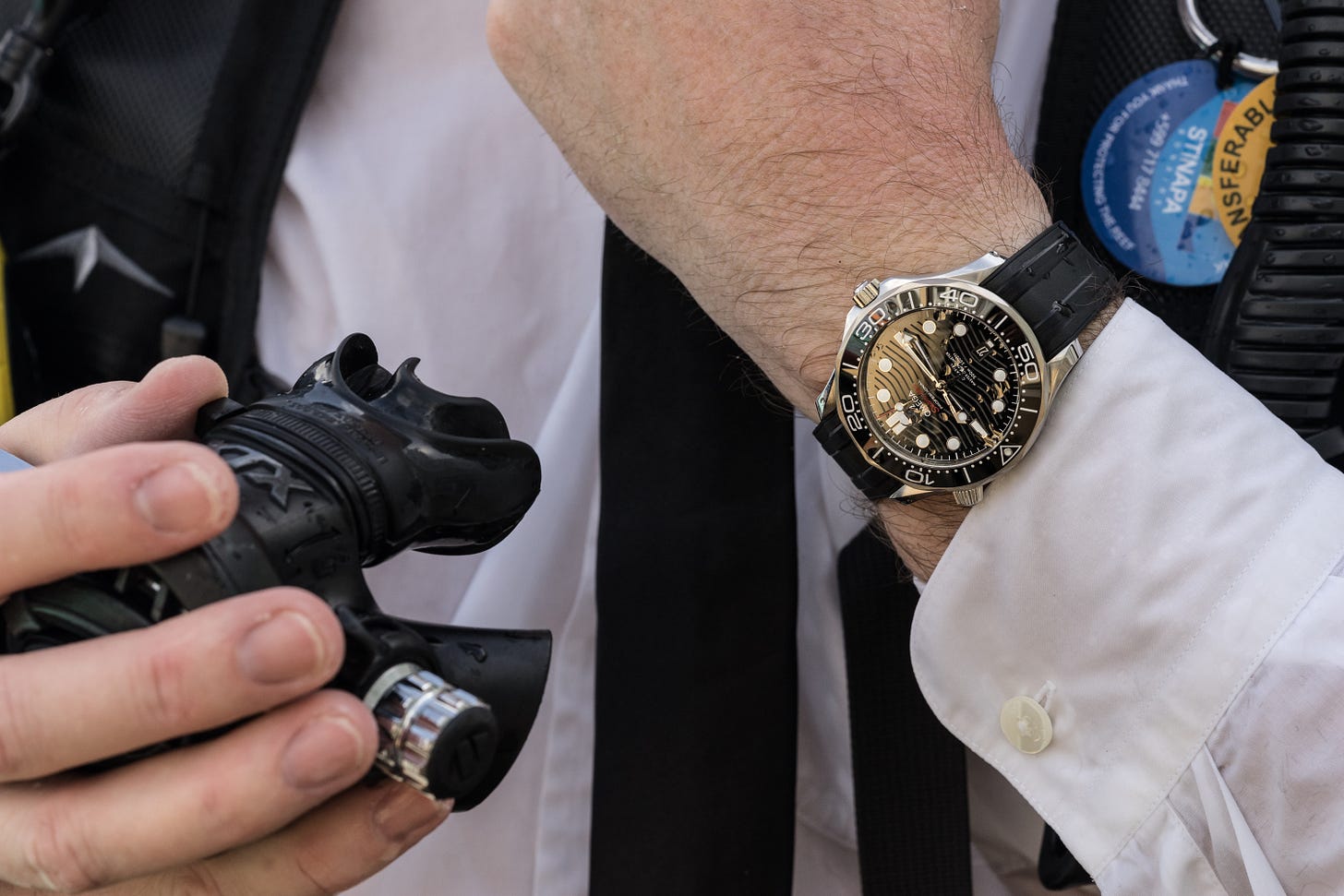A few weeks ago on The Grey NATO, the podcast I co-host, the topic of an episode was “Watch Discomfort Zones”. In it, James Stacey and I discussed the genre of watch that we’ve each never fully embraced. James chose the chronograph. I chose the dress watch. We both vowed to face our discomforts and give these heretofore neglected categories an honest try, in the hopes that we might one day come to appreciate, wear, and even own, them. This long-term experiment would require trying a watch in semi-regular wear and, while it’s not science on par with finding a COVID-19 vaccine, to a writer like me, who makes a living writing about watches, it seemed a worthy venture to expand my narrow horizons.
Coming to watches years ago from the outdoor gear world, I never paid much attention to the finer timepieces better suited to “the great indoors”. I was always drawn to dive watches, pilot’s watches, field watches, and chronographs. A watch was a tool and should be able to live on the wrist 24/7 and survive any scenario, planned or unplanned. If you have to jump into a swimming pool to save a drowning child, or change a stranded granny’s tire in the pouring rain, the last thing you should have to think about is the watch on your wrist, right? Leather straps, polished cases, delicate movements, and kitchen sink water resistance just don’t cut it. There’s a reason why James Bond and Dirk Pitt wore dive watches. Men of action need an Omega or a Doxa strapped on tight.
The other factors in my go-to choice in wrist wear are my work and my lifestyle. I’ve largely forged my professional reputation by writing about, and reviewing, dive watches in the environment for which they’re built; i.e., underwater. When I attended the big watch trade shows like Baselworld or SIHH, I’d usually only take meetings with the brands that had some sort of sports watch offering, leaving the Piagets and Pateks to others. Know your strengths, I thought. I have a passing appreciation for watch movements and complications, but I couldn’t tell you the advantage of a Breguet overcoil hairspring, or describe the traditional finishing required for the Geneva Seal. My idea of haute horlogerie is a watch that can be worn while traversing the Haute Route.
I also have worked from home since 2004. No offices, no dress codes, no co-workers aside from the cats. A dive watch on a NATO strap works well here and transitions perfectly into after work adventures, whether that be kayaking, hiking, biking or wrenching on the Land Rover. Something dressy on the wrist is a bit incongruous with a T-shirt, shorts and Birkenstocks in summer, or a sweater and jeans and, again, Birkenstocks, in winter. And then there’s the lume issue. I am one of the odd people who wears a watch to bed. I’ve done it ever since high school. I’m a light sleeper and like the ability to open a bleary eye, if something awakens me in the wee hours, to check the time. And you never know when there’s a house fire or zombie attack, and I’ll have to tie bed sheets together and shimmy out the window. When that happens, do I want to be fumbling for my dress watch before I make my escape?
OK, so now that I’ve laid out my formidable argument against wearing a dress watch, what would compel me to wear one? After all, I’m equally not comfortable with pink dress shirts or 1980s American family sedans, and I’m not rushing to reverse those discomforts anytime soon. Well, for one, if you haven’t noticed, I’m a bit of a romantic sentimentalist (cf. Land Rover, waxed canvas, my bookshelf). I want to be the kind of man who can confidently wear a dressier watch. I like the idea of the classic man’s watch. You know, the one your granddad wore to work, then came home and cut the grass in, read his paper and smoked his pipe wearing it, and then laid on his dresser or bedside table before going to sleep. In the days before a watch became an optional luxury collectible, a man often bought one sturdy good looking watch to wear for everything. Many were marketed as “waterproof," which was good enough for just about anything short of scuba diving and were used as such. Small, often with lovely sunburst dials and slow ticking movements on brittle leather straps, these watches—Bulovas, Omegas, Hamiltons— saw more action than the majority of the luxury dive watches sold today yet would be squarely considered dress watches now. Watches are a lot tougher than we give them credit for.
We watch enthusiasts are spoiled for choice these days, and have been offered countless watches with specific uses such as timing race laps, bombing sorties, and decompression stops, never mind that for all these activities, a mechanical wristwatch is largely obsolete. The fact is, when I go for a long bike ride or skiing, I take off my mechanical watch anyway and strap on a Garmin that tracks my speed, heart rate, and distance. It’s simply the right tool for the job, just as the Rolex Oyster Perpetual (or Smiths, depending on which story you believe) Hillary wore up Everest was in 1953. When I dive, I do wear a watch, but it’s mainly for nostalgic reasons, or often for an editorial or commercial assignment. So assuming I’m not wearing my watch for all of this rough and tumble, I might as well wear whatever one I want for the 99% of my life that is spent piloting a keyboard, running grocery sorties, or diving in the dirty dishes.
Before I move on, I should clarify what I mean (or don’t mean) by a “dress watch”. The definition embraced by many a watch nerd usually says that it must be precious metal, have no complications (even a seconds hand) and be worn on a black leather strap. My own take on a dress watch is less strict and, in fact, I don’t really have a definition. To date, my dressiest watch has been a Grand Seiko GMT (ref. SBGM021) that I bought in Tokyo. It is 38 millimeters across, has a creamy white dial, faceted hands and an exquisitely finished movement. It even came on a crocodile strap. I never wear it. Make no mistake, it is a gorgeous watch, a modern classic from a storied brand. But somehow, it is too dressy for me. So I set out to find one that fits my reality and my sense of aesthetic. I think I’ve found a worthy example: the anOrdain Model 1 with Iron Cream dial.
anOrdain is a small Glasgow, Scotland based watch company that is best known for its expertise in creating handcrafted vitreous enamel dials. This skill, which takes precision, training and a lot of patience, is only done “in-house” by a handful of luxury brands. I’ve admired anOrdain for a couple of years, particularly their design inspirations, their unpretentious artistry, and their accessibility. The typeface used on the watch dial numerals was inspired by the font used on old British Ordnance Survey topographical maps, the hands from old compass needles, and the strap is made from goatskin, same as the flight jackets worn by RAF pilots. The name of the company is from a “loch” (lake) in the Scottish Highlands, where the idea for the brand was conceived. Now doesn’t that sound like a watch I can get behind? I reached out to Lewis Heath, anOrdain’s founder, and he was willing to send me a watch to try out for a while.
The Model 1 may be dressy, with its spare cream enamel dial, slim 18 millimeter strap and shiny case, but it’s also one that I can imagine being worn hiking in a careworn wool sweater, then driven home in an old Land Rover to a roaring fire and a dram of smoky Scotch. I told you, I am a romantic sentimentalist. But tell me I’m wrong here. After all, if watches aren’t necessary tools anymore, what are we left with besides the feelings they evoke in us? And when I was chatting with Lewis Heath, he said, “I never like watches being mollycoddled, so the thought of it helping keep the [Land Rover] Series 3 going makes me very happy.”
In many ways, the approaching winter is a good time to try wearing a dressier timepiece more. It is a season of long sleeves, indoor time, and less sweaty activities (shoveling snow notwithstanding). I think I would have a much harder time moving to a leather-strapped enamel-dialed watch in July. Then it’s all about nylon straps and quartz divers for me (I will resist the strong urge to try the anOrdain on an Admiralty Grey NATO). That said, we’re in the middle of a pandemic and my typically casual dress code has become even more so with an utter lack of outside socializing. One of my hopes is that elevating my wrist game will have the side effect of inspiring me to elevate my sartorial game a bit. After all, even being housebound, I can make use of all those magnificent sweaters I’ve collected over the years, maybe even shovel the front walk in a tweed jacket. And yes, this dress watch.
Thus begins my frivolous horological experiment. I’ll be providing periodic updates on The Grey NATO podcast and perhaps here in the future. No doubt I’ll lapse and instinctively reach for those blunt instruments I’m so accustomed to, but the other thing about having a dressier watch is embracing the notion that, with some watches, you don’t have to wear them all the time to appreciate them. It’s OK to take it out, wind it up, admire the creamy enamel and blued steel hands, and then strap on the burly diver when I’m feeling a bit more Neanderthal. I make no promises that I’ll emerge a changed man—well coiffed and nattily dressed—but maybe I’ll gain a new appreciation for the subtler, more refined end of the horological spectrum. And what about granny’s flat tire, the drowning child, and fleeing the zombie apocalypse? I’ll just have to take care of business with a little more style.







When my Dad hit some success back in the 70s he did as many other did and still do, purchased a Rolex. He put the dressy Seiko he wore in Vietnam in a drawer and wore his gold Presidential for the next twenty years, and I can't ever recall it being off his wrist. He'd go to work with it on, landscape, oil changes, fix our broken bike chains, scuba dive, swim in the pools and oceans on vacation... everything. I think it's because of this that I don't ever shy away from wearing my watches for anything and everything. They're made to be worn, and they can take a beating. There's nothing cooler than seeing someone with a beat to hell dress watch on their wrist. Great write up as usual, Heaton!
I understand the attitude, I mirror it when it comes to tool watches. See, for growing up in the 90s and 2000s, it was difficult not to embrace smartwatches as a gym instrument or a wrist diving computer for scuba. As such, "rough" luxury watches always seemed like an oxymoron for me. It took some time - and some new sports such as yacht sailing - to embrace the idea of an analogue, less functional function watch. To embrace their slower pace. Appreciate their history.
A dress watch, on the other hand, was always useful, never questioned. Something worn with a suit, useufl in a way a tie or a cufflink is. And since I work in diplomacy the least formal thing I wear Monday to Friday (or used to before the pandemic...) is a blazer. Hence, the dress watch is entirely functional to me.